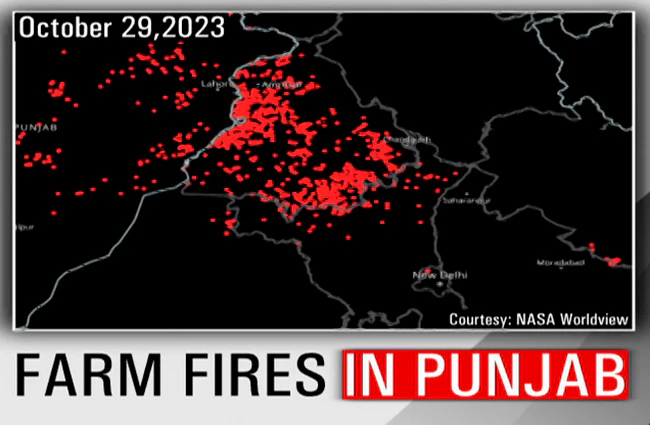Table of Contents
This Post Is Recently Updated on Oct 30, 2023 @ 21:59 pm by TBB Desk
1. Sudden Spike in Farm Fires
Punjab witnessed a staggering 740% rise in agricultural fires on Sunday, recording 1,068 incidents – marking the peak for a single day in the ongoing harvest season. In contrast, the preceding Saturday reported a mere 127 occurrences of stubble burning.
2. NASA Satellite Imagery Captures the Incident
Images from NASA’s Worldview satellite have chronicled the stubble burning episodes in Punjab from October 25 to 29, with red dots illustrating the locations of these fires.
3. Farm Fires Trend Over Several Days
On comparing the imagery, a proliferation in red dot clusters is evident on October 26 as opposed to October 25. Following a notable escalation in fire incidents on October 27, a sharp downturn was observed on October 28 (Saturday).
4. Sharp Rise on October 29
However, a resurgence in farm fires was observed on the succeeding Sunday, pervading extensive areas of the state. On October 29, Punjab documented 1,068 agricultural fire incidents.


5. Emergency Response Initiated
In response to the satellite imagery alerts, local administration has mobilized its fire brigade teams to tackle the fires. In areas inaccessible to the fire brigade, alternative methods are being employed to extinguish the fires.
6. Comparative Decline in Farm Fires
Remarkably, despite the recent surge, a 57% reduction in farm fires has been recorded from September 15 to October 29 when compared to the same period last year. During this span, the state reported 5,254 incidents as opposed to 12,112 in the corresponding period of the preceding year.
7. Weather Phenomena Delaying Stubble Burning
The observed reduction can be ascribed to flooding and other unforeseen weather events, which have postponed stubble burning. With the expectation that harvesting activities will intensify in the forthcoming weeks, the Centre’s Commission for Air Quality Management (CAQM) forewarns of potential increases in stubble burning.
8. Impact on Air Quality
The practice of burning paddy straw in Punjab and Haryana has been identified as a contributory factor to the severe escalation in air pollution levels observed in the national capital during October and November.
9. Quick Field Clearance Post-Harvest
Due to the narrow window available for sowing the Rabi crop — wheat — post paddy harvest, some farmers resort to setting their fields ablaze to expediently clear crop residue, paving the way for the subsequent sowing season.
10. Financial Support for Crop Residue Management
The Centre has earmarked approximately ₹ 3,333 crore under the Crop Residue Management Scheme for the state governments of Punjab, Uttar Pradesh, Rajasthan, and Delhi. This fund is designated to subsidize the acquisition of machinery by individual farmers, custom hiring centres, and cooperatives, facilitating in-situ management of paddy straw and the procurement of baling/raking machines and equipment for ex-situ applications.










